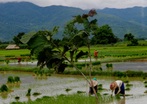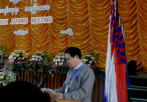 Photo: Students, Burma/Myanmar
Photo: Students, Burma/Myanmar Between DBN and TTD villages, there is a little river called Weh Loh. So, the village situated on the river bank is called Weh Loh village. Weh Loh had never known a school, until recently. Even though the villagers farmed the land, the war had forced out any coordinated educational effort. Weh Loh’s children travelled to neighboring villages for their lessons or went without. More often than not, they went without.
In recent years, a KNLA commander was moved by the plight of Weh Loh: while children in peaceful democracies all over the world spent the daylight in classrooms, the children of Weh Loh were at home, playing in the street, or working the fields alongside their parents. And so, he undertook a coordinated effort with village elders to establish a school. His efforts were successful.
Today, the School at Weh Loh provides basic education to the future leaders of Weh Loh. The children of Weh Loh now have reading, writing, and spelling courses – in three languages: Karen, English, and Burmese. And
despite the constant presence of war—of depleted rations, ambushes, and threats of violence, the School boasts three teachers and thirty students this year, from kindergarten through fourth standard. With these seeds of educational growth, the School’s founders hope that the children of Weh Loh will experience the promise of a better life.
Until recently, I only knew the school by reputation. Weh Loh is bordered on all sides by the Dictatorship’s military battalions, always at attention. But, on my way home this year, I unexpectedly stumbled upon the village of Weh Loh. The School’s founders built the school on a track of land adjacent to the village entrance, a testament to strength in the face of the most oppressive adversity. I could hear it before I saw it: the voices of children singing, reading, and reciting.
What I see through the School at Weh Loh is an organically home-grown effort for development in the war zone. No Norwegian Initiative is needed. Weh Loh obviously does not seek attention of the international community. There is no complaint as to how they have been disregarded by the caring world in the face of extreme misfortune – war. They may not be able to get very far with their humble effort. But, theirs is a genuine effort, an authentic little step to what they understand as national development through education for children.
Naw May Oo
July 2012
In recent years, a KNLA commander was moved by the plight of Weh Loh: while children in peaceful democracies all over the world spent the daylight in classrooms, the children of Weh Loh were at home, playing in the street, or working the fields alongside their parents. And so, he undertook a coordinated effort with village elders to establish a school. His efforts were successful.
Today, the School at Weh Loh provides basic education to the future leaders of Weh Loh. The children of Weh Loh now have reading, writing, and spelling courses – in three languages: Karen, English, and Burmese. And
despite the constant presence of war—of depleted rations, ambushes, and threats of violence, the School boasts three teachers and thirty students this year, from kindergarten through fourth standard. With these seeds of educational growth, the School’s founders hope that the children of Weh Loh will experience the promise of a better life.
Until recently, I only knew the school by reputation. Weh Loh is bordered on all sides by the Dictatorship’s military battalions, always at attention. But, on my way home this year, I unexpectedly stumbled upon the village of Weh Loh. The School’s founders built the school on a track of land adjacent to the village entrance, a testament to strength in the face of the most oppressive adversity. I could hear it before I saw it: the voices of children singing, reading, and reciting.
What I see through the School at Weh Loh is an organically home-grown effort for development in the war zone. No Norwegian Initiative is needed. Weh Loh obviously does not seek attention of the international community. There is no complaint as to how they have been disregarded by the caring world in the face of extreme misfortune – war. They may not be able to get very far with their humble effort. But, theirs is a genuine effort, an authentic little step to what they understand as national development through education for children.
Naw May Oo
July 2012





 RSS Feed
RSS Feed

